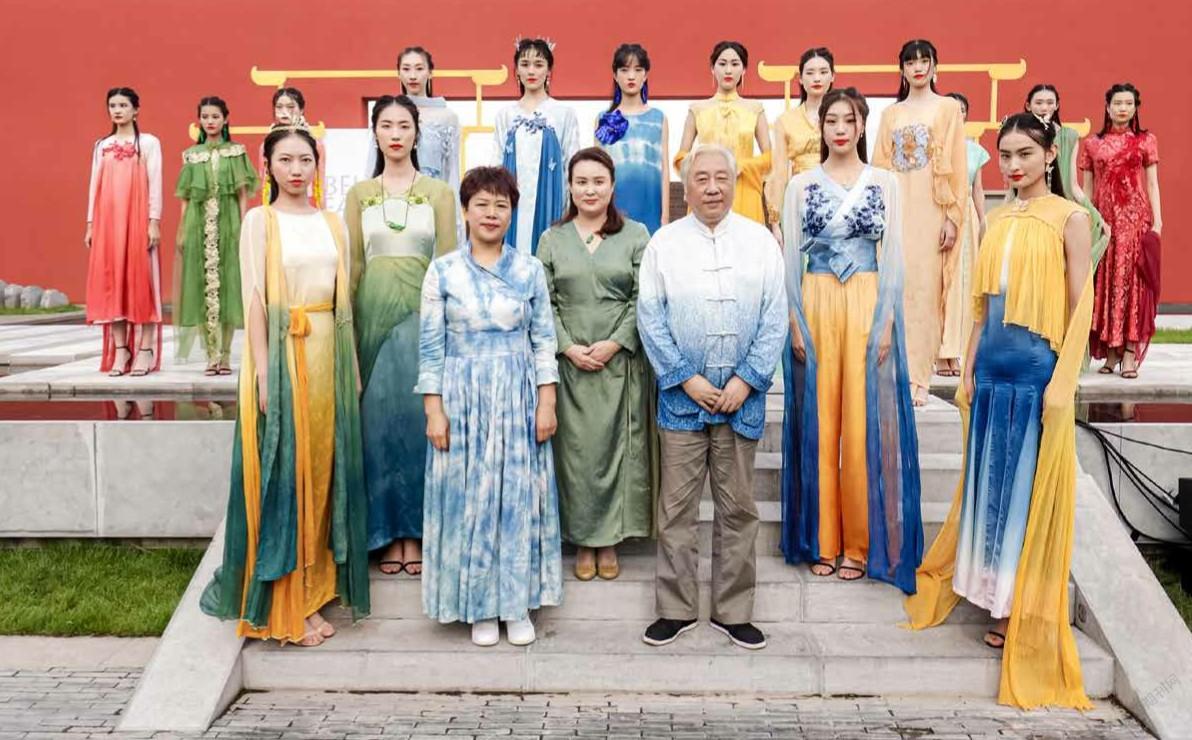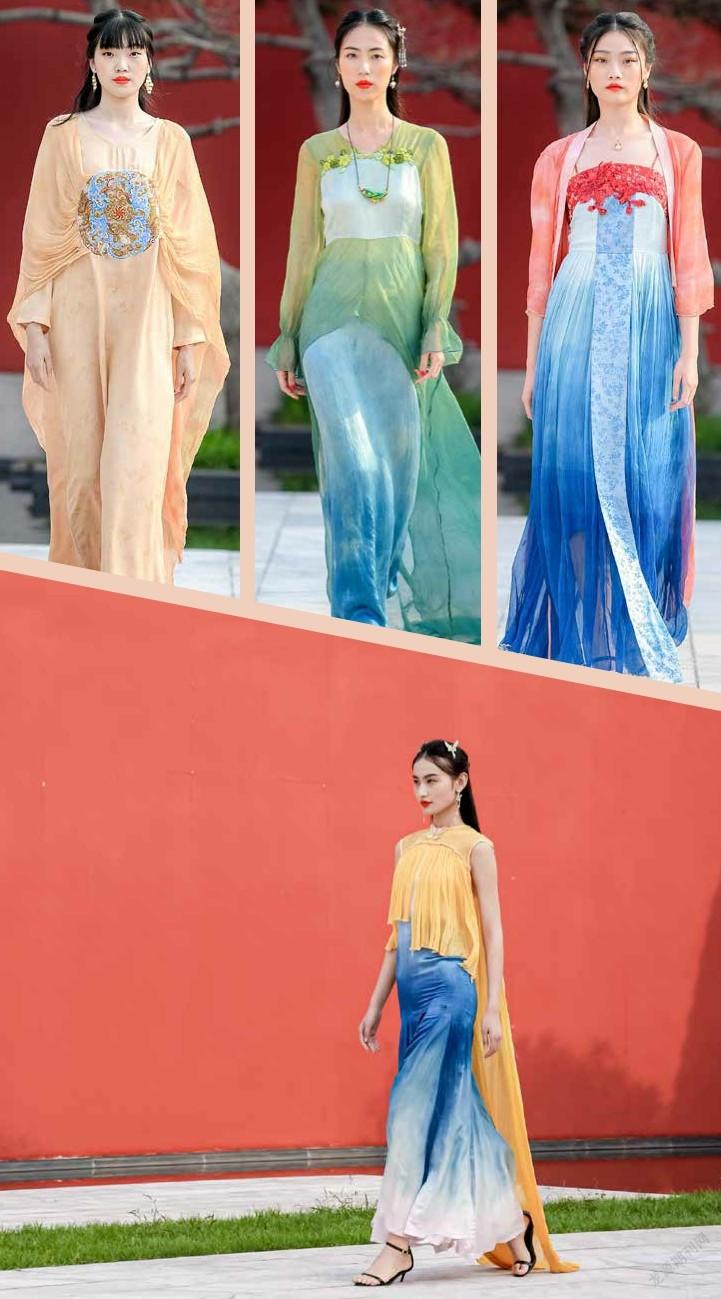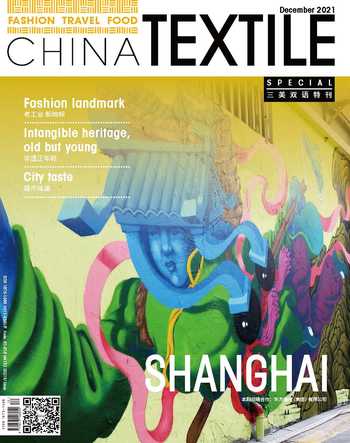把古老的植物染,带进现代时尚生活

非遗匠心,光耀东方。近日,愉悦YUE BAST首席设计师王恕儿以作品“万物幻彩染华章”在北京时装周上奉献了一场东方美学创意大秀。秀演作品融入了敦煌色系的色彩元素,以色彩变幻的桑蚕丝面料呈现简约而典雅的设计,廓形收腰等工艺加上天然面料的飘逸感,使得作品展现出灵动脱俗之美。
秀演充分延续和体现了愉悦YUE BAST独到的工艺和产品特点——植物染色和幻彩面料。愉悦通过与中纺院江南分院及其特聘专家、植物染色非遗传承人黄荣华合作,共同致力于植物染料与工艺的产业化技术攻关,从而将中国非遗传统工艺结合当代时尚设计,输出传承传统文化的现代产品。
“Inheritance of Intangible Cultural Heritage, Brilliance in the Orient” creative Hanfu show was held in Beijing’s new cultural landmark Longfu Cultural Square recently during Beijing Fashion Week. Wang Shuer, chief designer of YUE BAST, presented a creative show of Oriental aesthetics with her work. The color of clothing blends into the elements of Dunhuang, obtains color inspiration from nature, and presents the smart and refined beauty of this collection with simple and elegant silhouette and natural fabrics such as mulberry silk.
The show fully continued and reflected the unique process and product characteristics of YUE BAST — plant dyeing and multicolor fabrics. The works released adopt the plant dyeing technology jointly developed by the Jiangnan Branch of CTA and Mr. Huang Ronghua, distinguished expert, and the inheritor of the plant dyeing intangible cultural heritage, which combines the ancient traditional dyeing and printing process with modern industry, and develops modern fashion products with traditional culture.
CT:作為本届北京时装周开幕秀参与品牌,请介绍一下本次秀演的灵感来源和设计理念?
王恕儿:本次秀演的设计灵感来自敦煌壁画,加入现代元素与之相融合。我们用色彩变幻的桑蚕丝面料呈现设计,用收腰廓形的工艺与飘逸感的天然面料相结合,追求一种灵动出尘的美。
此外,这套系列成衣色彩全部来自纯天然植物染料,工艺既有面料染色,也有手工成衣染色。同时运用的素染、绞缬、吊染渐变等多种染色技艺,应该说呈现了当今比较高超的植物染技艺水平。
为了准备这次秀演,我们从面料的纹织结构到染色设计都是从零开始着手,所有产品都是第一次发布,希望将中国纺织非遗传统工艺与当代时尚设计结合,注重继承与创新,呈现出我们中国传统文化的自信。
CT:在秀演作品材质运用上,YUE BAST有哪些特色?
王恕儿:本次秀演运用了愉悦家纺的幻彩面料。幻彩面料是通过独家的纺纱技术,采用一根幻彩纱线实现变幻万千色彩斑斓的面料。这项关键技术获得了第七届“中国十大纺织科技奖”,填补了国际国内在色纺技术上的空白。
目前,愉悦家纺的研发方向以绿色产品为主,比如我们的婴幼儿产品是可啃咬的,非常环保安全。后续我们会继续以“天人合一”的理念从大自然中寻找高品质产品原料。
CT:非遗植物染的应用越来越受到市场的关注,本次秀演对于植物染的运用,背后是怎样运作的?
王恕儿:在植物染上我们和中纺院江南分院及其特聘专家、植物染色非遗传承人黄荣华老师合作,共同致力于植物染料与工艺的产业化技术攻关,打造“可再生纤维+天然环保染色工艺+可自然降解”的全生命周期环保低碳工艺路线。
CT:与其他工艺相比,植物染色在设计研发上有什么难点,目前技术产业化的成果怎样?
王恕儿:植物染的难点是天然助剂的产业化应用和生产上,但这并不是很大的问题。当今社会做天然助剂领域研究的人非常少,我们和黄荣华老师共同研究打造天然助剂,已成功实现红、黄、蓝、棕、灰等二十余种色系植物染料在婴童装、家居服、时装服饰及家纺产品上的产业化应用。
CT:您怎么看待亚麻的研发空间和时尚趋势,未来YUE BAST的设计研发方向是什么?
王恕儿:愉悦家纺的亚麻面料非常高品质,我们的亚麻是在乌克兰种植的。我认为亚麻的研发空间非常大,它本身具有天然、舒适、环保、抗菌的特性,而且具有非常好的肌理效果。我们研发重点是麻和其他纤维的混纺,既优化了麻的手感、垂感,又保持了麻本身的天然特性。

CT:在國潮兴起、中国式美学回归的当下,您认为传统纹样色彩、非遗工艺是否迎来复兴契机,您在这方面哪些思考和建议?
王恕儿:中国有着历史悠久的文化传统,我们的丝绸和染色工艺要比西方国家出现得早,并且更加成熟。比如植物染色远在周朝开始就有历史记载,有着数千年的历史文化积淀,于2013年成功申报省级非物质文化遗产。我相信随着文化自信的提升,未来的非遗工艺将迎来很好的发展契机,我们也将让古老的传统印染工艺和现代工业结合,实现合理有效的工业化产品输出,研发承载传统文化的现代时尚产品。
CT: As a participating brand in the opening show of this year’s Beijing Fashion Week, could you please tell us the source of inspiration and design concept of this show?
Wang Shuer: The design inspiration of this show comes from Dunhuang frescoes, and it is integrated with modern elements. It presents the smart and refined beauty of this collection with simple and elegant silhouette and natural fabrics such as mulberry silk.
In addition, the colors of this collection are all from natural plant dyes, and the process is both fabric dyeing and hand dyeing. Meanwhile, it uses many dyeing techniques, such as uniformly dyeing, tie-dye, dip dye, which shows the level of today’s superior plant dyeing skills.
In order to prepare for this show, we started from the texture structure of the fabric to the dyeing design, and all products were released for the first time. We hope to combine the traditional Chinese textile intangible cultural heritage technology with contemporary fashion design, pay attention to inheritance and innovation, and present the confidence of Chinese traditional culture.
CT: What are the characteristics of YUE BAST in the use of materials in the show’s works?
Wang Shuer:This show uses the multicolor fabric of Yuyue Home Textile. The multicolor fabric is the use of a multicolor yarn to achieve a variety of colorful fabrics through the unique spinning technology. This key technology won the seventh “China Top Ten Textile Science and Technology Award”, filling the gap in color spinning technology at home and abroad.
At present, Yuyue Home Textile’s research and development products are mainly green, such as baby products can be gnawed, very environmental protection and safety. We will continue to look for high-quality raw materials from nature in the future.
CT: The application of plant dye of intangible cultural heritage is attracting more and more attention from the market. How does this show operate on the application of plant dyeing?
Wang Shuer: We cooperate with Professor Huang Ronghua, distinguished expert of the Jiangnan Branch of CTA and the inheritor of the plant dyeing intangible cultural heritage. We are committed to the industrialization technology of plant dyes and processes, and create the whole life cycle environmental protection and low-carbon process of “renewable fiber + natural envi- ronmental protection dyeing process + natural degradation”.
CT: Compared with other processes, what are the difficulties in the design and development of plant dyeing, and what are the achievements of the current technology industrialization?
Wang Shuer:The difficulty of plant dyeing is the industrial application and production of natural auxiliaries, but this is not a big problem. There are very few people doing research in the field of natural auxiliaries. We jointly researched and created natural auxiliaries with Professor Huang Ronghua, and have successfully realized the industrial application of more than 20 kinds of color plant dyes such as red, yellow, blue, brown and gray in baby and children’s clothing, home clothing, fashion clothing and home textile products.
CT: What do you think of the R&D space and fashion trend of linen? What is the R&D direction of YUE BAST in the future?
Wang Shuer:Yuyue’s linen is of high quality and the flax is grown in Ukraine. I think the research and development space of linen is very large, it has natural, comfortable, environmental protection, antibacterial properties, and has a very good texture effect. Our research and development focuses on the blending of flax and other fibers, which not only optimizes the feel and drape of linen, but also maintains the natural characteristics of flax itself.
CT: With the rise of Chinese fashion and the return of Chinese aesthetics, do you think traditional patterns and colors and intangible cultural heritage crafts will usher in a revival opportunity? What are your suggestions?
Wang Shuer: China has a long history of cultural tradition, Chinese silk and dyeing technology appeared earlier than Western countries, and more mature. For example, plant dyeing has been recorded as far back as the Zhou Dynasty and has thousands of years of historical and cultural accumulation. It was successfully declared as provincial intangible cultural heritage in 2013. I believe that with the improvement of cultural confidence, the intangible cultural heritage technology in the future will usher in a good opportunity for development. We will also combine the ancient traditional dyeing and printing technology with modern industry, realize reasonable and effective industrial product output, and develop modern fashion products with traditional culture.

